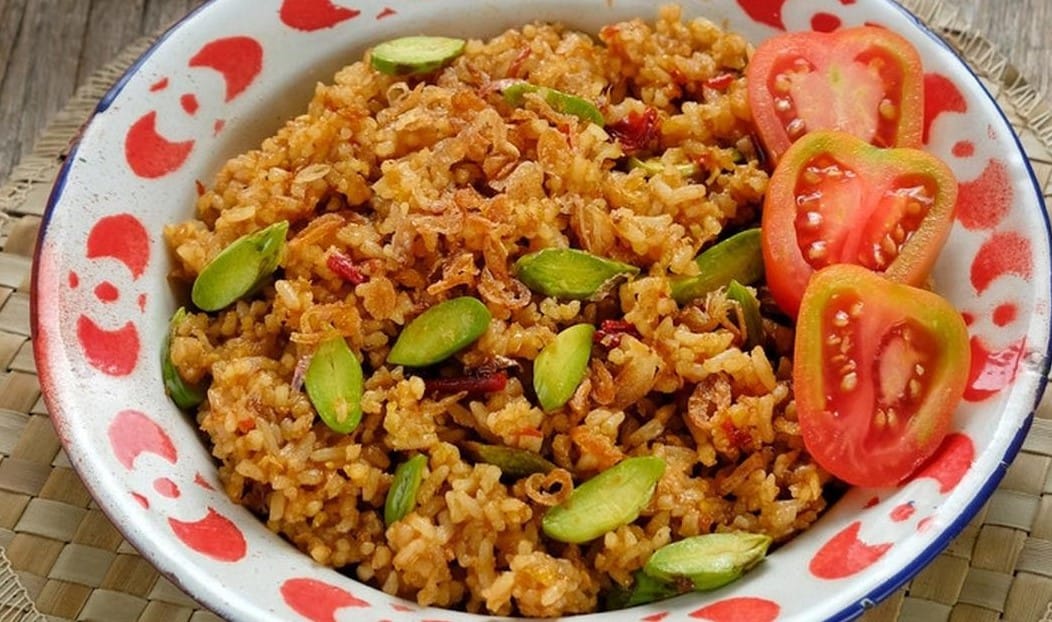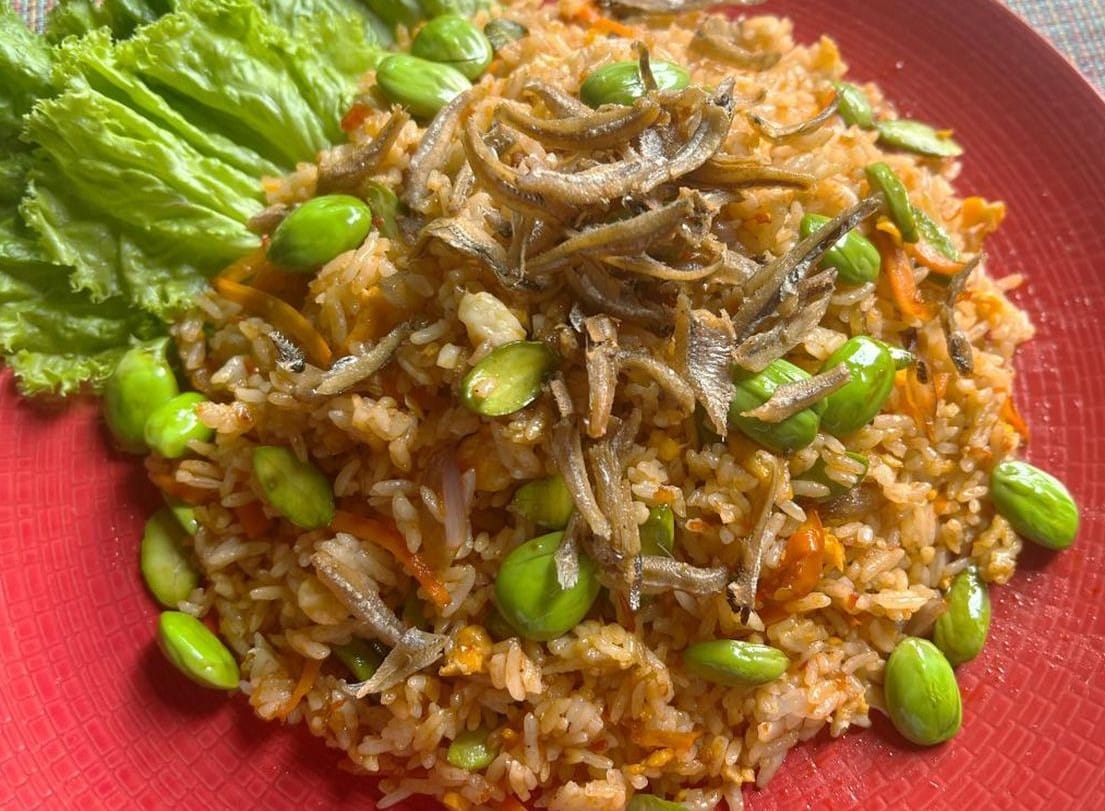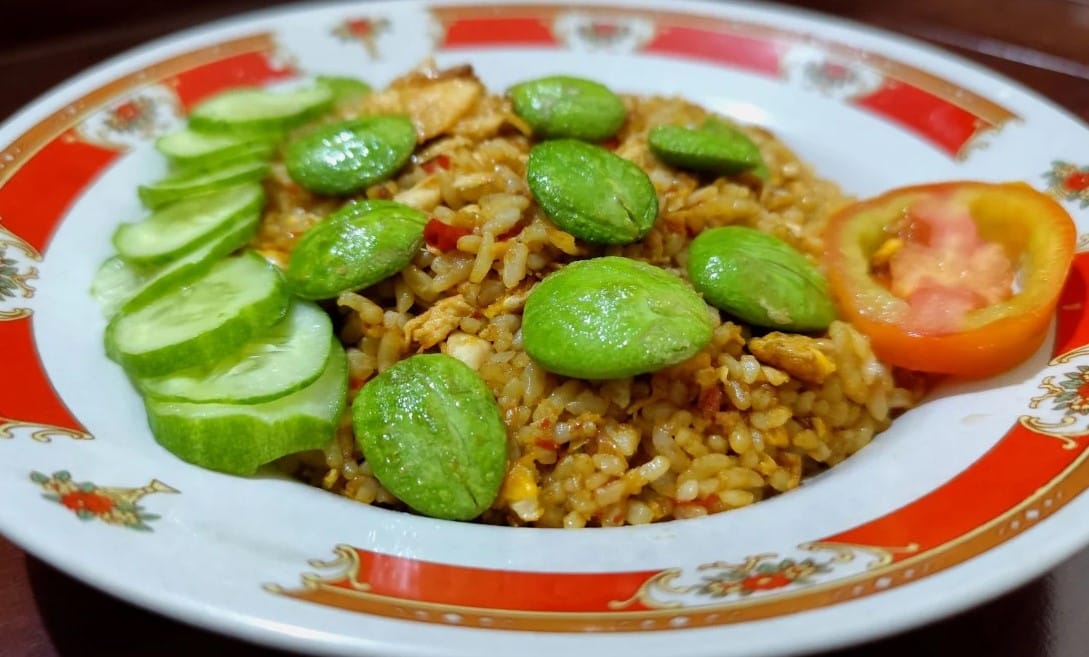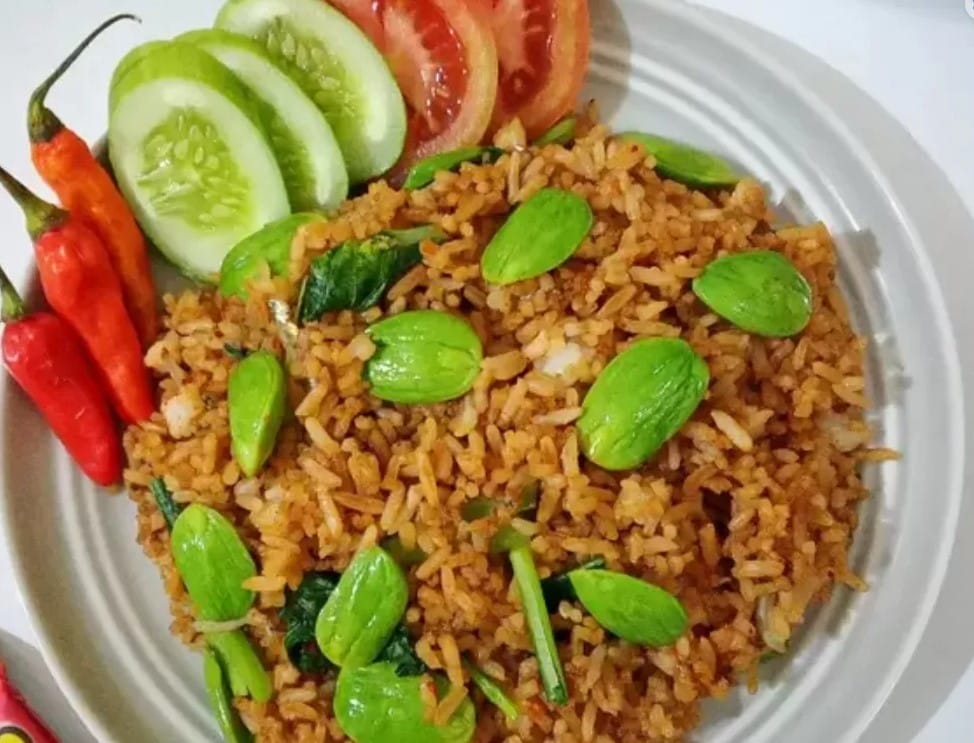A plate sits before you. Steam rises, curling into the air like a whisper of promise. The aroma hits you first – pungent, savory, alluring, a siren call to the senses. This is nasi goreng pete, a dish that embodies the spirit of Indonesian cuisine. It is fried rice with stink beans, a dish both humble and bold, simple yet profound. Making it is straightforward, a dance of ingredients and heat. Eating it is an experience, a journey through flavors and textures.

The Ingredients
To begin, you need rice. Not just any rice, but day-old rice. It is drier, the grains separate easily, crumbling into individual pearls. Fresh rice clumps together, a mass of starch. You want each grain to stand alone, to be its own entity in the dish.
Pete beans are the heart of this dish. Green, flat, and curved, they have a strong smell, an acquired taste that lingers. They are not for everyone, but for those who love them, they are irreplaceable. You can find them at Asian markets, nestled among other exotic produce. If you cannot find pete, you can skip it, but know that it will not be the same. The dish will lack its soul.
Gather your aromatics. Shallots, garlic, and chili peppers are essential. Bird’s eye chilies are ideal, their heat sharp and clean. If you cannot find them, regular red chilies will suffice, bringing warmth and color to the dish.
Protein comes next. Chicken is traditional, its flavor mild and comforting. Shrimp works too, adding a touch of sweetness. Use both if you like, a surf-and-turf of sorts. Eggs are non-negotiable, their richness binding the dish together.
For seasoning, you need sweet soy sauce, its syrupy sweetness a counterpoint to the savory elements. Regular soy sauce adds depth, salt brings balance, and white pepper adds a gentle heat.
Oil for frying is the final ingredient. It is the medium through which all these elements come together, the conductor of this culinary symphony.

Prep Work
Preparation is key. Chop everything small, each piece a note in the melody. Mince the garlic, its pungency released with each cut. Slice shallots thin, their sweetness waiting to be unlocked. Dice chilies fine, their heat ready to ignite the dish. Cut chicken into bite-sized pieces, each morsel a promise of protein. Peel shrimp if using, their flesh tender and sweet.
Split pete beans lengthwise, revealing their inner skin. Scrape it out, for it is bitter and unwelcome. Leave the beans whole if you prefer, their shape a testament to their origin.
Beat eggs in a bowl, their yolks and whites mingling. Set them aside, ready to be transformed.
Have everything ready. The cooking goes fast, a whirlwind of heat and motion.

The Cooking
Heat your wok, make it hot, a cauldron of potential. Add oil, swirling to coat the surface, a slick canvas for your art.
Toss in aromatics. Shallots first, their sweetness released by the heat. Then garlic, its pungency rising. Then chilies, their heat blooming. Stir fast, a dance of ingredients. Do not let them burn, for they are the foundation of flavor.
Add chicken if using, its flesh searing, turning from pink to white. Stir-fry till no longer pink, each piece cooked through. Add shrimp if using, their bodies curling, turning pink, a sign of readiness.
Push everything to the side, creating space. Pour in beaten eggs, their liquid form setting slightly. Scramble them, their richness mingling with the other ingredients.
Now the rice goes in, a cascade of grains. Break up any clumps, each grain a separate entity. Stir to coat with oil, the grains glistening. Keep it moving, a constant motion.
Add pete beans, their presence unmistakable. Stir to distribute, their flavor infusing the dish.
Season the dish. Sweet soy sauce first, its syrupy sweetness enveloping the rice. Regular soy sauce next, adding depth. Sprinkle salt, a touch of balance. Dash of white pepper, a hint of heat. Taste, adjust, find the balance.
Keep stirring, let rice crisp slightly, a hint of texture. It should smell fragrant, a bouquet of aromas. Steam should rise, a sign of readiness.
It’s done when it looks done. Trust your senses, they will not lead you astray.

The Serving
Mound rice on a plate, a mountain of flavor. Top with a fried egg if you like, its yolk a golden crown. Sunny side up is best, the runny yolk mixing in, adding richness.
Serve with sliced cucumber, its cool crunch a contrast to the hot rice. Add tomato wedges for color, their acidity a counterpoint.
Sprinkle with fried shallots, their crunch adding texture, their flavor a final note.
Sambal on the side, for extra heat. Not traditional, but good, a fiery addition.
The Eating
Breathe in the aroma, let it fill your nose. Pungent pete, savory rice, spicy chilies, a symphony of scents.
Take a bite, feel the textures. Soft rice, crispy bits, crunchy pete, a dance of contrasts.
Taste the flavors. Sweet, salty, spicy, umami, a balance of elements.
Eat slowly, savor each mouthful. This is comfort food, but it’s also complex, a journey of flavors.
The Variations
Nasi goreng allows creativity, a canvas for your culinary expression. Use what you have, make it your own.
Try different proteins. Beef works, its flavor robust. So does tofu, its texture a contrast.
Vary the vegetables. Add green peas, their sweetness a surprise. Diced carrots, their color a pop. Corn kernels, their sweetness a delight.
Change the seasoning. Use fish sauce for depth, its umami a revelation. Add oyster sauce for richness, its flavor a luxury.
Make it spicier. Add more chilies, their heat a challenge. Or sambal, its fire a thrill. Or both, if you dare.
Omit the pete for a milder version, but try it at least once. It’s the soul of this dish, a flavor like no other.
The History
Nasi goreng is old, centuries old, a dish born of necessity. A way to use leftover rice, a testament to resourcefulness.
Chinese influence is clear, the stir-frying technique, the soy sauce seasoning, a legacy of trade and migration.
But it’s purely Indonesian now, a national dish, a symbol of identity. Found everywhere, from street carts to fine dining, a dish for all.
Pete beans add local flavor, a touch of the land. They grow wild, cultivated too, a part of the landscape. Used in many dishes, but they shine in nasi goreng, their flavor unmistakable.
The Culture
Nasi goreng is more than food, it’s part of life. A breakfast staple, a late-night snack, comfort food supreme.
It crosses class lines, rich and poor eat it. Home-cooked or from a cart, always satisfying, always welcome.
Tourists seek it out, a taste of the exotic. Locals eat it daily, a part of their routine. A unifying dish, a part of national identity.
The Technique
Making nasi goreng is about feel, an art more than a science. No exact measurements, adjust to taste, find your balance.
High heat is crucial, keeps rice from steaming. You want to fry, not steam, a dance of heat and motion.
Work fast, keep ingredients moving, prevents burning, ensures even cooking.
Use a wok if you have one, its shape ideal. A large frying pan works too, need room to toss and turn, to let the ingredients dance.
Don’t overcrowd the pan, cook in batches if needed. Better texture that way, each grain its own entity.
The Timing
Nasi goreng cooks fast, a whirlwind of heat and motion. Have everything ready before you start, preparation is key.
Prep takes longer than cooking, do it in advance if you can. Be ready, be prepared, the cooking is swift.
Serve immediately, it’s best hot from the wok. Loses something as it sits, a dish best enjoyed fresh.
The Accompaniments
Nasi goreng can be a meal itself, a complete dish. But sides enhance it, elevate it.
Kerupuk on the table, shrimp crackers, adds crunch, soaks up flavors.
Acar on the side, pickled vegetables, cuts through richness, adds tang, a refreshing contrast.
Satay pairs well, grilled meat skewers, makes it a feast, a celebration of flavors.
The Drink Pairing
Beer goes well, a cold lager, cuts spice, refreshes palate, a perfect match.
Iced tea works too, sweet and cold, balances heat, a soothing companion.
For non-alcoholic, try es cendol, a coconut milk drink, sweet and cooling, a tropical delight.
The Aftermath
Your plate is empty, satisfaction sets in. You’ve eaten well, a meal to remember.
The kitchen smells of spices, a lingering aroma of pete, not unpleasant, a reminder of the meal.
Cleanup is easy, one-pan cooking, minimal fuss, a simple task.
You’ll make this again, soon, it’s addictive that way, a dish to return to.
The Final Word
Nasi goreng pete is simple food, but it’s not simplistic. Layers of flavor, contrasting textures, a complete meal in a dish.
It’s a taste of Indonesia, in your own kitchen, authentic, satisfying, worth mastering.
Try it once, you’ll be hooked. The humble fried rice, elevated by pungent pete, a culinary adventure on a plate. A dish that tells a story, a story of flavor, of culture, of life.
Nasi goreng pete is more than just a meal; it is a connection to a rich culinary tradition. It is a dish that invites you to explore, to experiment, and to enjoy. It is a dish that brings people together, a shared experience of taste and satisfaction. So gather your ingredients, heat your wok, and embark on this culinary journey. The reward is a plate of nasi goreng pete, a dish that is as satisfying to make as it is to eat. Enjoy the process, savor the flavors, and share the experience with those you love. This is the simple art of nasi goreng pete, a dish that is truly worth mastering.
